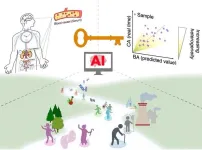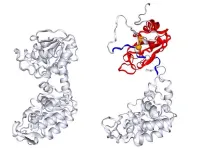(Press-News.org) We’ve mapped nearly all of Mars’ surface from orbit, yet we know less about Earth’s ocean floor — almost 75% remains unmapped in high resolution.
This terrestrial blind spot is driving NJIT Mathematics Professor Eliza Michalopoulou’s latest research, funded by the Office of Naval Research (ONR). The project aims to improve how scientists explore the vast, uncharted ocean floor through sound.
“Mapping the seabed is a challenging endeavor due to the extreme conditions,” said Michalopoulou, chair of NJIT’s Department of Mathematical Sciences. “The immense pressure is crushing at depths like the Pacific’s Mariana Trench, for example, where it reaches over 1,000 times sea-level atmospheric force, making it difficult and costly to deploy submersibles for exploration. The remarkably low temperatures further complicate efforts.”
Rather than sending equipment into such depths, Michalopoulou’s research harnesses underwater sound waves to study the ocean remotely.
“By ‘listening’ to the ocean, we can analyze its properties and characteristics without the need to physically deploy extensive equipment into the depths of the vast underwater world,” she added.
Michalopoulou is currently investigating a fundamental mathematical question crucial to both ocean exploration and naval defense operations — how do physical properties of the ocean shape the way sound travels beneath the surface?
Her field, called geoacoustic inversion, uses mathematical models to transform underwater sound waves into detailed information about stretches of the seafloor, revealing everything from bathymetry (depth) to sediment density and sub-bottom layering. It can also help scientists explore the habitats and migration patterns of marine life.
“The process relies on underwater microphones, called hydrophones, that capture sound waves,” Michalopoulou explained. “We integrate this acoustic data with mathematical models to understand how sound interacts with the seabed. This helps us predict how signals — like those from submarines — travel through water and what they should ‘look’ like when received.”
However, Michalopoulou says there’s a challenge — different methods for analyzing this acoustic data often paint conflicting pictures of the same seafloor.
“Different methods can point to completely different structures in the seabed layers,” she explained. “Understanding the properties of the seabed is pivotal for things like defense operations and environmental conservation, but we need to understand why these methods disagree to be confident in our data.”
These variations arise from the fundamental complexity of mathematical modeling. “Some approaches assume oceanographic conditions, like currents and their influence on sound speed, are known,” Michalopoulou said. “Others treat both ocean processes and sediment properties as unknowns, which can lead to significantly different interpretations of the same data.”
Real-world factors further complicate the picture. Ship traffic and marine life create acoustic interference that can distort measurements. To understand these variations, Michalopoulou is applying modeling simulations that can help reveal the true properties of the ocean floor below.
“The problem is that the ocean floor is largely a mystery, and we usually don’t know the true properties of the seabed, so it is difficult to assess how well a given method performs in mapping it accurately,” said Michalopoulou. “With advanced mathematical models, we can now create realistic simulations where the true environmental conditions are known. This allows us to evaluate different mapping methods and understand their variability.
“In three years, we expect to have thoroughly analyzed a wide range of approaches, assessing their accuracy, inherent uncertainty and potential for real-time application,” she added. “The insights and conclusions drawn from this research will contribute to high-fidelity seabed exploration, ultimately enhancing the effectiveness of anti-submarine warfare strategies.”
Michalopoulou’s project is underway amid other global efforts like the Seabed 2030 project and UNESCO’s Ocean Decade, contributing to broader initiatives to map and explore Earth’s ocean floor.
Since Michalopoulou joined NJIT in 1994, the ONR has supported her leading research efforts in the fields of underwater acoustics and signal processing. In 2022, she was named Distinguished Lecturer by the Institute of Electrical and Electronics Engineers’ Oceanic Engineering Society and has also been named Fellow of the Acoustical Society of America, among many other distinctions.
Michalopoulou’s project, “A Simulation Study for Assessing Accuracy, Uncertainty, and Consistency in Geoacoustic Inversion Across Methodologies,” recently commenced under ONR’s Basic and Applied Scientific Research program.
END
NJIT mathematician to help map Earth's last frontier with Navy grant
With an Office of Naval Research grant, NJIT’s Eliza Michalopoulou aims to help scientists map Earth’s last frontier — the uncharted expanses of the planet’s ocean floor.
2025-03-14
ELSE PRESS RELEASES FROM THIS DATE:
NASA atmospheric wave-studying mission releases data from first 3,000 orbits
2025-03-14
Following the 3,000th orbit of NASA’s AWE (Atmospheric Waves Experiment) aboard the International Space Station, researchers publicly released the mission’s first trove of scientific data, crucial to investigate how and why subtle changes in Earth’s atmosphere cause disturbances, as well as how these atmospheric disturbances impact technological systems on the ground and in space.
“We’ve released the first 3,000 orbits of data collected by the AWE instrument in space and transmitted back to Earth,” said Ludger Scherliess, principal investigator for the mission and physics professor at Utah State University. “This is a view of atmospheric ...
‘Microlightning’ in water droplets may have sparked life on Earth
2025-03-14
Life may not have begun with a dramatic lightning strike into the ocean but from many smaller “microlightning” exchanges among water droplets from crashing waterfalls or breaking waves.
New research from Stanford University shows that water sprayed into a mixture of gases thought to be present in Earth’s early atmosphere can lead to the formation of organic molecules with carbon-nitrogen bonds, including uracil, one of the components of DNA and RNA.
The study, published in the journal Science Advances, adds evidence – and a new angle – to the much-disputed Miller-Urey ...
Smoke from wildland-urban interface fires more deadly than remote wildfires
2025-03-14
EMBARGOED until Friday, March 14 at 2:00 p.m. Eastern Time (12 noon MT)
Contacts:
David Hosansky, NSF NCAR and UCAR Manager of Media Relations
hosansky@ucar.edu
303-497-8611
Audrey Merket, NSF NCAR and UCAR Science Writer and Public Information Officer
amerket@ucar.edu
303-497-8293
The smoke from fires that blaze through the wildland-urban interface (WUI) has far greater health impacts than smoke from wildfires in remote areas, new research finds.
The study, published this week in Science Advances, estimates that emissions from WUI fires are proportionately about three times more likely to lead ...
What’s your body really worth? New AI model reveals your true biological age from 5 drops of blood
2025-03-14
Osaka-Japan - We all know someone who seems to defy aging—people who look younger than their peers despite being the same age. What’s their secret? Scientists at Osaka University (Japan) may have found a way to quantify this difference. By incorporating hormone (steroid) metabolism pathways into an AI-driven model, they have developed a new system to estimate a person’s biological age a measure of how well their body has aged, rather than just counting the years since birth.
Using just five drops of ...
Protein accidentally lassos itself, helping explain unusual refolding behavior
2025-03-14
UNIVERSITY PARK, Pa. — Proteins are long molecules that must fold into complex three-dimensional structures to perform their cellular functions. This folding process occasionally goes awry, resulting in misfolded proteins that, if not corrected, can potentially lead to disease. Now, a new study has described a potential mechanism that could help explain why some proteins refold in a different pattern than expected. The researchers, led by chemists at Penn State, found that a type of misfolding, in which the ...
With bird flu in raw milk, many in U.S. still do not know risks of consuming it
2025-03-14
PHILADELPHIA – Although the Food and Drug Administration (FDA) located H5N1 bird flu virus in samples of raw, or unpasteurized, milk in tests in four states in April 2024, and bird flu has been detected in commercially sold raw milk, many Americans do not know that consuming raw milk and its products poses greater health risks than consuming pasteurized milk and its products, especially for children. Consuming raw milk can expose one to Salmonella, E. coli, Campylobacter, Cryptosporidium, Listeria, and Brucella – and, potentially, H5N1 bird flu.
A majority of U.S. adults (56%) knows that drinking raw milk from cows, sheep, or goats is less safe than drinking pasteurized milk. ...
University of Minnesota research team awarded $3.8 million grant to develop cell therapy to combat Alzheimer’s disease
2025-03-14
MINNEAPOLIS/ST. PAUL (03/14/2025) — A University of Minnesota research team was recently awarded a five-year, $3.8 million grant from the U.S. National Institutes of Health to develop a new cell therapy to combat Alzheimer’s disease. More than 55 million people worldwide live with dementia, which includes Alzheimer's disease and other related conditions.
The project aims to adapt advanced techniques developed for cancer treatment to create specialized macrophages — immune cells that can surround and remove proteins from their environment — to seek out and clear harmful proteins in the brain.
"Engineered ...
UConn uncovers new clue on what is leading to neurodegenerative diseases like Alzheimer’s and ALS
2025-03-14
In Nature Neuroscience, UConn School of Medicine researchers have revealed a new scientific clue that could unlock the key cellular pathway leading to devastating neurodegenerative diseases like Alzheimer’s disease, and the progressive damage to the brain’s frontal and temporal lobes in frontotemporal degeneration (FTD) and the associated disease amyotrophic lateral sclerosis (ALS).
The study, “Endothelial TDP-43 Depletion Disrupts Core Blood-Brain Barrier Pathways in Neurodegeneration,” was published on March 14, 2025. The lead author, Omar Moustafa Fathy, an MD/Ph.D. candidate at the Center for Vascular Biology at UConn School of ...
Resuscitation in out-of-hospital cardiac arrest – it’s how quickly it is done, rather than who does it
2025-03-14
Key takeaways:
The proportion of bystanders (as opposed to emergency medical services) performing cardiopulmonary resuscitation (CPR) on individuals experiencing out-of-hospital cardiac arrest (OHCA) has steadily increased over the past decades.
The study emphasises that the speed of CPR initiation, rather than who performs it, is crucial to survival and better outcomes.
Each 5-minute delay in return of spontaneous circulation in patients experiencing OCHA is associated with a 38% increased risk of death.
Based on these findings, the authors emphasise that increasing the number of individuals trained in proper CPR ...
A closer look at biomolecular ‘silly putty’
2025-03-14
Biomolecular condensates are shifting blobs in our cells that organize cellular matter. They are distinct molecular communities made of DNA, RNA and proteins that “condense” molecules to key locations, yet they frequently defy description. Partly this is because they are so small, they cannot be measured using traditional microscopes.
“These blobs were once described as being ‘liquid-like’ because some of them were observed to kiss, fuse, drip and flow like raindrops on windshields,” said Rohit Pappu, Gene K. Beare Distinguished Professor of biomedical engineering ...
LAST 30 PRESS RELEASES:
Cobalt-induced asymmetric electron distribution boosts photocatalytic hydrogen production efficiency
Ultra-low doping 0.1(PtMnFeCoNi)/TiO2 catalysts: Modulating the electronic states of active metal sites to enhance CO oxidation through high entropy strategy
Clinical use of nitrous oxide could help treat depression, major study shows
Report reveals potential of AI to help Higher Education sector assess its research more efficiently and fairly
Corporate social responsibility acts as an insurance policy when companies cut jobs and benefits during the times of crisis
Study finds gender gap in knee injuries
First ‘Bible map’ published 500 years ago still influences how we think about borders
Why metabolism matters in Fanconi anemia
Caribbean rainfall driven by shifting long-term patterns in the Atlantic high-pressure system, study finds
Potential treatment to bypass resistance in deadly childhood cancer
RSV vaccines could offer protection against asthma
Group 13 elements: the lucky number for sustainable redox agents?
Africa’s forests have switched from absorbing to emitting carbon, new study finds
Scientists develop plastics that can break down, tackling pollution
What is that dog taking? CBD supplements could make dogs less aggressive over time, study finds
Reducing human effort in rating software
Robots that rethink: A SMU project on self-adaptive embodied AI
Collaborating for improved governance
The 'black box' of nursing talent’s ebb and flow
Leading global tax research from Singapore: The strategic partnership between SMU and the Tax Academy of Singapore
SMU and South Korea to create seminal AI deepfake detection tool
Strengthening international scientific collaboration: Diamond to host SESAME delegation from Jordan
Air pollution may reduce health benefits of exercise
Ancient DNA reveals a North African origin and late dispersal of domestic cats
Inhibiting a master regulator of aging regenerates joint cartilage in mice
Metronome-trained monkeys can tap to the beat of human music
Platform-independent experiment shows tweaking X’s feed can alter political attitudes
Satellite data reveal the seasonal dynamics and vulnerabilities of Earth’s glaciers
Social media research tool can lower political temperature. It could also lead to more user control over algorithms.
Bird flu viruses are resistant to fever, making them a major threat to humans
[Press-News.org] NJIT mathematician to help map Earth's last frontier with Navy grantWith an Office of Naval Research grant, NJIT’s Eliza Michalopoulou aims to help scientists map Earth’s last frontier — the uncharted expanses of the planet’s ocean floor.



